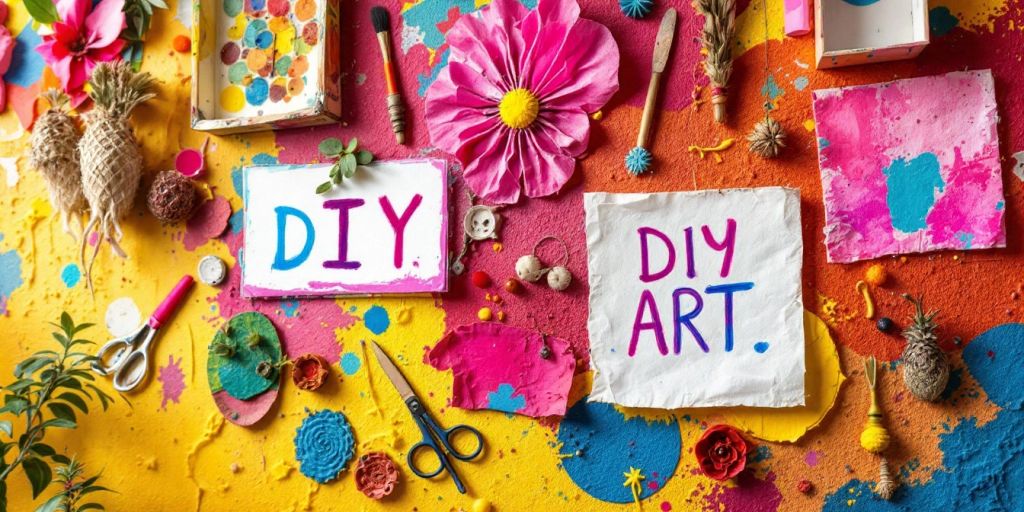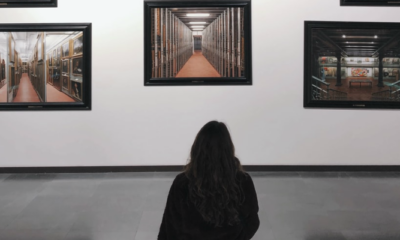Home and Garden
How to Add Texture to Your Space with DIY Wall Art

Adding textured wall art to your home can completely change its look and feel. It brings depth, warmth, and a unique character to your space. This article will guide you through the importance of texture in wall art, how to choose the right materials, and step-by-step instructions for creating your own pieces. Whether you’re a beginner or an experienced crafter, you’ll find useful tips and inspiration to enhance your home decor.
Key Takeaways
- Texture adds visual interest and depth to your walls.
- DIY wall art can be both budget-friendly and unique.
- Different materials can create various textures for your art.
- Textured art can enhance the atmosphere of any room.
- Experimenting with texture can help express your personal style.
Understanding the Importance of Texture in Wall Art
Textured wall art plays a crucial role in enhancing the overall look of a space. It adds depth and interest, making walls come alive. Here are some key points to consider:
Visual and Tactile Appeal
- Visual Interest: Textured art captures attention and draws the eye, creating a focal point in any room.
- Tactile Experience: The ability to touch and feel the textures adds a sensory dimension, making the space more engaging.
- Light Play: Textured surfaces interact with light, creating shadows and highlights that change throughout the day.
Creating Depth and Dimension
- Layering: Using different materials can create layers that add depth to your artwork.
- Contrast: Combining smooth and rough textures can enhance visual intrigue.
- Three-Dimensional Effects: Textured art can give the illusion of three-dimensionality, making the artwork feel more alive.
Enhancing Room Ambiance
- Mood Setting: Textured art can influence the mood of a room, making it feel warm and inviting.
- Personal Touch: Unique textures can reflect personal style, adding character to your home.
- Cohesion: When chosen carefully, textured art can tie together various elements of a room’s decor.
Incorporating textured wall art is not just about decoration; it’s about creating an environment that feels alive and inviting.
By understanding the importance of texture, you can transform your space into a visually captivating and emotionally engaging environment.
Choosing the Right Materials for DIY Textured Wall Art
Exploring Different Mediums
When it comes to creating textured wall art, the choice of materials is crucial. Here are some popular options:
- Acrylic Paint: Great for adding colour and texture.
- Joint Compound: Perfect for creating depth and dimension.
- Fabric Scraps: Adds a unique tactile element.
Budget-Friendly Material Options
You don’t need to spend a lot to create stunning textured art. Consider these budget-friendly materials:
- Recycled Canvas: Use old paintings or thrifted canvases.
- Household Items: Items like sponges or forks can create interesting textures.
- Natural Elements: Leaves or twigs can be incorporated for a rustic feel.
Sustainable and Eco-Friendly Choices
For those looking to be environmentally conscious, here are some sustainable options:
- Recycled Paper: Use old newspapers or magazines for collage.
- Non-Toxic Paints: Opt for eco-friendly paints that are safe for the environment.
- Natural Adhesives: Use glue made from natural ingredients to avoid harmful chemicals.
Choosing the right materials not only enhances the beauty of your art but also reflects your personal style and values. By exploring various options, you can create unique pieces that resonate with your space and ethos.
Step-by-Step Guide to Creating Textured Wall Art
Preparing Your Canvas
To start your textured wall art, you need a solid base. If you have an old painting that no longer excites you, consider repurposing it. Alternatively, you can buy a cheap canvas from a thrift store. If your canvas isn’t pre-primed, apply a coat of paint, such as white acrylic, to create a good foundation.
Applying Texture Techniques
Once your base coat is dry, it’s time to add texture. Use joint compound to create depth. Here’s how:
- Spread the joint compound evenly across the canvas using a putty knife. Don’t worry about making it perfectly smooth; a bit of unevenness adds character.
- Experiment with different tools to create unique textures. You can use anything from a fork to your fingers. The key is to have fun and let your creativity flow.
- Let it dry completely. This can take several hours or even a day. Make sure to keep pets away to avoid any unwanted paw prints!
Adding Finishing Touches
After the joint compound has dried, you can seal your artwork. You can use a clear sealant to maintain the soft white look or add colour with acrylics or spray paint. Feel free to mix colours for a more vibrant finish. Enjoy the process and let your personality shine through your art!
Incorporating Textured Art in Different Rooms
Textured art can transform any room in your home, adding depth and character. Here’s how to effectively incorporate it into various spaces:
Living Room Ideas
- Create a focal point: Use a large textured piece on a feature wall to draw attention.
- Accent pieces: Place smaller textured artworks on mantels or side tables for added interest.
- Eye-level display: Hang art at eye level to maximise its impact.
Bedroom Inspirations
- Above the bed: A large textured piece can serve as a stunning statement above the headboard.
- Gallery wall: Combine smaller pieces in a gallery style to create a personal touch.
- Asymmetrical arrangements: Experiment with different layouts to keep the space visually engaging.
Dining Room Enhancements
- Above sideboards: Position textured art above dining furniture to create a focal point.
- Complement the setup: Ensure the art matches the overall dining decor for a cohesive look.
- Layering: Use multiple pieces to add depth and interest to the dining area.
Textured art not only beautifies your space but also invites interaction, making your home feel more welcoming.
By thoughtfully placing textured art in these key areas, you can enhance the overall ambiance of your home, making it a more inviting and visually appealing environment. Consider the size and colour palette of your art to ensure it complements your existing decor.
Exploring Various Techniques for Textured Wall Art

Using Drywall Compound
One popular method for adding texture to your wall art is by using drywall compound. This technique allows you to create a variety of textures, from smooth to rough. Here’s how to do it:
- Prepare your surface: Ensure your canvas or wall is clean and dry.
- Apply the compound: Use a putty knife to spread the compound onto the surface.
- Create patterns: Experiment with different tools, like brushes or sponges, to create unique textures.
Experimenting with Mixed Media
Mixed media art combines various materials to create depth and interest. Here are some ideas:
- Paint: Use acrylics or oils for vibrant colours.
- Fabric: Incorporate pieces of fabric for a tactile experience.
- Found objects: Add items like buttons or twigs for a unique touch.
Incorporating Natural Elements
Bringing nature into your art can enhance its texture. Consider these options:
- Leaves: Use real leaves to create imprints.
- Sand: Mix sand into your paint for a gritty texture.
- Wood: Attach small wooden pieces for a rustic feel.
Textured wall art not only beautifies your space but also invites interaction, making it a wonderful addition to any room.
By exploring these techniques, you can create stunning textured wall art that adds character and depth to your home.
DIY Textured Art Projects for Beginners
Creating textured art can be a fun and rewarding experience, especially for beginners. Here are some simple projects to get you started:
Simple Techniques to Try
- Using Joint Compound: This is a great way to add texture. Apply it to a canvas and use various tools to create patterns.
- Collage Art: Gather materials like fabric, paper, or natural elements. Layer them on a canvas for a unique look.
- Painting with Texture Paste: Mix paint with texture paste to create a thick, textured surface that adds depth to your artwork.
Common Mistakes to Avoid
- Overloading on Texture: Too much texture can overwhelm the piece. Start with a little and build up gradually.
- Not Sealing Your Work: Always seal your textured art to protect it from dust and damage.
- Ignoring Drying Times: Be patient! Allow each layer to dry completely before adding more.
Tips for Success
- Experiment Freely: Don’t be afraid to try different materials and techniques. Art is about exploration!
- Use Quality Materials: Invest in good quality paints and tools for the best results.
- Have Fun: Enjoy the process and let your creativity flow!
Advanced Textured Art Projects for Experienced Crafters
Creating textured art can be a thrilling challenge for those with some experience. Here are some advanced projects that will push your creativity and skills to new heights.
Challenging Techniques
- Layering with Mixed Media: Combine various materials like fabric, paper, and paint to create depth.
- Using Moulds and Stencils: Create unique shapes and patterns by using moulds or stencils with joint compound or plaster.
- Incorporating Lighting: Use LED lights behind or within your art to enhance textures and create a stunning visual effect.
Incorporating Multiple Textures
- Contrast: Mix rough and smooth surfaces to create visual interest.
- Natural Elements: Incorporate items like wood, stones, or leaves for an organic feel.
- Textile Additions: Use fabric or yarn to add softness and warmth to your piece.
Creating Large-Scale Pieces
- Planning: Sketch your design on a large canvas or wall before starting.
- Teamwork: Collaborate with other artists for larger projects, sharing ideas and techniques.
- Installation: Consider how your piece will be displayed; think about the space and how it interacts with the environment.
Experimentation is key. Don’t be afraid to try new techniques and materials to find your unique style.
By exploring these advanced projects, you can truly elevate your textured art and make a statement in any space. Remember, the journey of creating is just as important as the final piece!
Displaying and Arranging Textured Wall Art
Choosing the Right Location
When it comes to displaying textured wall art, the location is key. Here are some tips to help you decide:
- Eye Level: Hang art at eye level for maximum impact.
- Feature Walls: Use a feature wall to create a stunning focal point.
- Natural Light: Position art where it can catch natural light to enhance its textures.
Grouping and Layering Art Pieces
Arranging multiple pieces can create a dynamic look. Consider these methods:
- Gallery Wall: Create a gallery wall with various sizes and textures.
- Symmetrical Arrangement: For a balanced look, arrange pieces symmetrically.
- Asymmetrical Layout: For a more casual feel, try an asymmetrical layout.
Complementing Existing Decor
Your textured art should harmonise with your room’s decor. Here’s how:
- Colour Coordination: Choose art that matches or contrasts with your room’s colour scheme.
- Style Matching: Ensure the art style complements your furniture and other decor elements.
- Texture Balance: Mix different textures to create visual interest without overwhelming the space.
Textured wall art can transform a plain room into a vibrant space, adding depth and character. Consider how each piece interacts with its surroundings to create a cohesive look.
Maintaining and Cleaning Textured Wall Art
Textured wall art can add a unique charm to your home, but it also requires proper care to keep it looking its best. Here are some essential tips to maintain and clean your textured pieces effectively.
Regular Dusting and Cleaning
- Dust your art regularly using a soft, dry cloth or a feather duster to prevent dirt buildup.
- For deeper cleaning, use a damp cloth with mild soap, ensuring not to soak the texture.
- Avoid harsh chemicals that can damage the materials.
Repairing Damaged Textures
- If you notice any cracks or chips, use a small amount of joint compound to fill in the gaps.
- Allow the compound to dry completely before repainting or sealing the area.
- For larger damages, consider reapplying the texture technique used initially.
Protecting Art from Environmental Factors
- Keep your textured art away from direct sunlight to prevent fading.
- Maintain a stable humidity level in your home to avoid warping or cracking.
- Consider using a protective sealant to guard against dust and moisture.
Remember, regular maintenance not only preserves the beauty of your art but also enhances its longevity.
By following these simple steps, you can ensure that your textured wall art remains a stunning focal point in your home for years to come. Regular care will keep it vibrant and appealing, adding to the overall atmosphere of your space.
Inspiration from Famous Textured Artworks

Historical Examples
Textured art has a rich history, with many famous artists incorporating texture into their works. Here are a few notable examples:
- Vincent van Gogh: His use of thick brush strokes in paintings like "Starry Night" creates a dynamic texture that draws viewers in.
- Anselm Kiefer: Known for his large-scale works, Kiefer often uses materials like straw and ash, adding a tactile quality to his pieces.
- Jean Dubuffet: His art often features rough surfaces and unconventional materials, challenging traditional notions of beauty.
Modern Masterpieces
In contemporary art, texture continues to play a vital role. Some modern artists to explore include:
- Yayoi Kusama: Her installations often use polka dots and repetitive patterns, creating a visual texture that captivates.
- Kara Walker: Known for her silhouettes, Walker’s work often incorporates layered materials, adding depth and complexity.
- Damien Hirst: His use of mixed media, including formaldehyde and paint, creates striking textural contrasts.
DIY Interpretations
You can draw inspiration from these famous artworks to create your own textured pieces. Consider:
- Experimenting with materials: Use items like fabric, paper, or natural elements to add texture.
- Playing with techniques: Try layering paint or using tools like sponges and brushes to create different effects.
- Finding your style: Look at the works of famous artists and think about how you can incorporate similar textures into your own art.
Textured art not only enhances visual appeal but also invites a tactile experience, making it a powerful addition to any space.
Benefits of Adding Texture with Wall Art
Improving Visual Interest
Adding texture to your walls can significantly enhance the visual appeal of your space. Textured art creates depth and draws the eye, making a room feel more inviting. Here are some benefits:
- Captivating Designs: Textured pieces can transform plain walls into stunning focal points.
- Light Play: The way light interacts with textures can create beautiful shadows and highlights.
- Unique Style: Textured art allows you to express your personal style, making your space feel unique.
Creating a Focal Point
Textured wall art can serve as a focal point in any room. It can:
- Draw attention to a specific area, like above a sofa or bed.
- Balance other design elements in the room.
- Encourage conversation and engagement among guests.
Enhancing Tactile Experience
Incorporating texture into your decor adds a tactile experience that can make your home feel more welcoming. This can:
- Invite touch and interaction, making the space feel alive.
- Create a sensory experience that engages more than just sight.
- Encourage a deeper connection with the art itself.
Textured art is not just about decoration; it’s about creating an environment that feels both engaging and personal.
In summary, adding texture through wall art can significantly improve the overall ambiance of your home, making it a more enjoyable and visually appealing space.
Final Thoughts
In conclusion, adding textured art to your home is a fantastic way to enhance its charm and character. It not only makes your space more interesting but also creates a warm and inviting atmosphere. Whether you choose to make your own art or find unique pieces from local artists, the options are endless. Remember to think about the size, colours, and types of textures that will fit well with your existing decor. So go ahead, unleash your creativity, and let your walls tell a story through the beautiful textures you choose!
-

 Business6 days ago
Business6 days agoS&P 500 Soars in Best May in Decades Amid Tariff Relief and Nvidia’s Surge
-

 Immigration6 days ago
Immigration6 days agoTrump’s Immigration Crackdown: Legal Battles and Policy Shifts
-

 Business6 days ago
Business6 days agoUS Stock Market Soars in May Amidst Tariff Tensions and Inflation Worries
-

 Government6 days ago
Government6 days agoTrump Administration’s Government Reshaping Efforts Face Criticism and Legal Battles
-

 Business6 days ago
Business6 days agoTrump’s Tariffs: A Global Economic Reckoning
-

 Foreign Policy3 days ago
Foreign Policy3 days agoInside Schedule F: Will Trump’s Federal Workforce Shake-Up Undermine Democracy?
-

 Press Release3 days ago
Press Release3 days agoIn2space Launches Campaign to Make Space Travel Accessible for All













